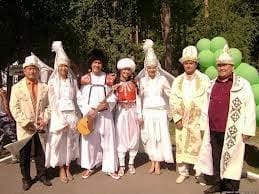- INTRODUCTION –
Kyrgyzstan also known as Kirghizia is a country situated in Central Asia. It is a landlocked country with mountainous terrains. Having a record span of 2,000 years, it encompasses a variety of cultures and empires. Being an isolated country has helped it preserve its ancient culture. This country has been at crossroads of several great civilizations as the Silk road and other commercial and cultural routes. Before 1991, Kyrgyzstan was under the rule of the USSR. After independence, the capital of Kyrgyzstan is Bishkek.
3/4th of the population consist of the Kyrgyz, a Muslim Turkic people. The remaining 1/4th consists of Uzbeks. Since independence, many Russians and Germans have emigrated. Since Independence the sovereign state has been officially declared as a unitary parliament republic. “Kyrgyz” is believed to been derived from a Turkic word “forty”. Kyrgyz means we are forty. In October 1991, Askar Akayev became the President of Kyrgyzstan as he won 95% of the votes from the public. In 2005, a popular uprising known as the “Tulip Revolution” took place after the parliamentary elections in March 20015, forced President Akayev to resign on 04 April 2005.

- ABOUT –
CLIMATE – Kyrgyzstan’s great distance from the oceans and sharp change of elevation from the adjacent plains strongly influence the country’s climate. Heavy snowfalls in winter lead to spring floods which often cause serious damage downstream. Kyrgyzstan has a significant amount of deposits such as gold and rare-earth metals. Due to the country’s predominantly mountainous terrain, less than 8% of the land is cultivated.

PEOPLE – The Kyrgyz, formerly a transhumant (nomadic) people were settled into collectivized agriculture by the Soviet regime. Besides Kyrgyz, the country’s population includes minorities of Russians, Uzbeks, Ukrainians and Germans as well as Tatars, Kazakhs, Dungans, Uighurs and Tajiks.

TRADE – The people of Kyrgyzstan have traditionally raised livestock and engaged in farming. By the late of the 20th century, the republic had become a source for nonferrous metals, notably of antimony and mercury ores. Gold mining has increased in importance and Kyrgyzstan possesses substantial coal reserves and some petroleum and natural gas deposits. Hydroelectric power provides more than 3/4th of the country’s electric energy.
AGRICULTURE – Industrialization has stimulated the mechanization of agriculture in Kyrgyzstan, and many types of machines necessary to cope with the largely mountainous terrain are manufactured in the republic. Unlike other Central Asian countries, Kyrgyzstan does not suffer from a lack of water; irrigation canals have increased agricultural output substantially.

ECONOMY – The national bank of Kyrgyz Republic serves as the central bank of Kyrgyzstan. Agriculture is an important sector in the economy of Kyrgyzstan. In 2002, agriculture accounted for 35.6% of GDP and about half of employment. Kyrgyzstan is rich in mineral resources but has negligible petroleum and natural gas reserves, it imports those. Among its mineral resources, metallurgy is an important industry and the government hopes to attract foreign investment in this field. The country’s plentiful water resources and mountainous terrains enable it to produce and export large quantities of hydroelectric energy.
POPULATION – Kyrgyzstan’s population is estimated at 6,389,500 in 2019. Of those, 34.4% are under the age of 15 and 6.2% are over 65. The country is rural: only about one-third of the population live in urban areas. The average population density is 25 people per km².

EDUCATION – Earlier before 1989, the whole generation received their education in the Russian language. After 1989, Kyrgyz was made the official state language and was introduced as a subject. An obstacle to the research and scholarship is the general lack of competence in European languages among the educated Kyrgyz.
SCIENCE AND TECHNOLOGY – The headquarters of the Kyrgyz Academy of Sciences is located in Bishkek, where several research institutes are located. Kyrgyz researchers are developing useful technologies based on natural products, such as heavy metal remediation for purifying waste water.
SPORTS – Football is the most popular sport in Kyrgyzstan. The official governing body is the Football Federation of Kyrgyz Republic, which was founded in 1992, after the split of the Soviet Union. It administers the Kyrgyzstan national football team. Some of the other sports played Wrestling, Ice hockey, Martial arts, boxing, etc.

MANUFACTURING – The chief industries are the manufacture of machinery and electronic components, but food processing and light industries are also important and utilize local agricultural materials such as meat, fruit, and vegetables. Wool is the most exportable product, and mills weave cotton and silk fabrics, worsted cloth, and knitted garments. Leather goods are also produced.
- TEXTILES:
Kyrgyzstan has trade relations with India, Russia, Vietnam, etc. The country has also developed a handicraft industry in the Kyrgyz villages. In 2013, Kyrgyzstan had hired up to 3,00,000 women for employment. The Kyrgyzstan technical university and the International trade union have joined forces to create a training center for skilled workers and managers in the textile and clothing industry, one of the fastest growing industry. The Kyrgyzstan textile and clothing sector is currently worth up to 15% of GDP and employs more than 200,000 people – more than 90% of whom are women.
Till 2010, the country faced political instability and economic stagnancy, which resulted in an absence of economic reforms and policies to help the industrialization of the country. With the result, the country’s clothing industry is facing technological obsolescence, low labor productivity, and absence of manufacturing and quality standards. Kyrgyzstan caters to just 2-5% of the Russian market demand.
As global competition in the sector has accelerated in recent decades, Kyrgyz garment manufacturers have been forced to adapt to shifts in supply chains and are now positioning themselves to meet this international demand.

- COSTUMES:
Kyrgyz clothing reflects the lifestyle and regions of Kyrgyzstan, with designs and materials drawn from nomadic life. Wool, felt, leather, skins, and coarse cloth are the main materials used for Kyrgyz clothing, with ornamentation taken from tribal traditions and nature. Even though many people wear Western clothing, traditional elements are still visible everywhere, and people are proud of their traditional clothing in Kyrgyzstan.
The kalpak is perhaps the most famous item of clothing in Kyrgyzstan. A tall hat, made of white felt, it is usually worn by men after the age of 6. Men also wore a chapan, a coat with a high collar, and suede or leather trousers. Sometimes honored guests are presented with an intricately embroidered kalpak and long embroidered felt coat, called a chepken.
Women often wore a beldemchi, a skirt with a slit in the front, over a basic dressing gown or dress. For ceremonial occasions, dresses with ruffles on the sleeves and skirt are the most common, worn with embroidered vests and conical hats with feathers in the top (called shokulo). A large headdress made of up to 30 m (100 feet) of intricately wrapped fabric, called an elechek, was traditionally worn by women, and is still popular for ceremonies and festivals today.

- EMBROIDERY:
Embroidery was a very popular and widespread type of needlework that was practiced by Kyrgyz women of all ages, from young to old. This kind of needlework in comparison with other traditional crafts was more individualistic. For the traditional embroidery ornament, local colors are inherent, without the use of their shades. The system of semantic values of colors developed for centuries reflects the national mind set. The most common color in ornamental compositions of embroidery is red. It’s the color of life, love and festivity. Green, white, yellow and blue colors are also among most favorites. Black color was rare, mostly used for the outline. Currently, in Kyrgyzstan, hand embroidery is used mostly in the expensive dress for special occasions.

ARTICLE BY:
VRIDHI BHAGNARI.
CONTACT DETAILS: [email protected]

